The Han Kuang military drills entered their seventh day yesterday, with a focus on prolonged defensive operations.
Units simulated a scenario in which the Chinese People’s Liberation Army (PLA) established beachheads in an invasion of Taiwan, requiring units to block its advance inland toward Taipei.
In New Taipei City’s Bali District (八里), the 269 Mechanized Infantry Brigade carried out defensive exercises against enemy forces that landed in the Port of Taipei, seeking to hold key strategic positions.
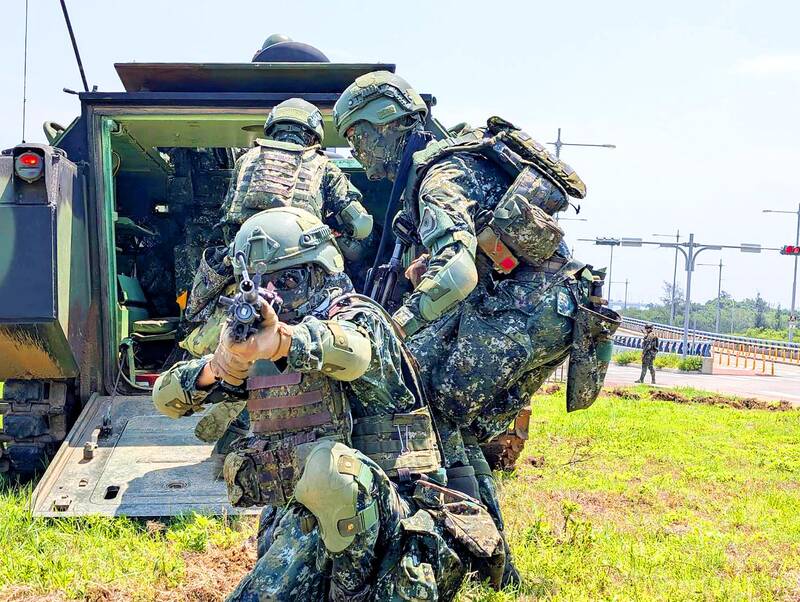
Photo: CNA
President William Lai (賴清德) inspected the unit and observed its drills early yesterday morning before visiting the navy’s Hai Feng Shore-based Anti-ship Missile Group.
The group deployed four launch vehicles, some of which were equipped with what looked to be extended-range Hsiung Feng III (HF-3) missiles, as well as a supporting communication vehicle.
This would be the first time the extended-range variant has been seen in public. It was developed by the Chungshan Institute of Science and Technology and reportedly has a range of up to 400km.
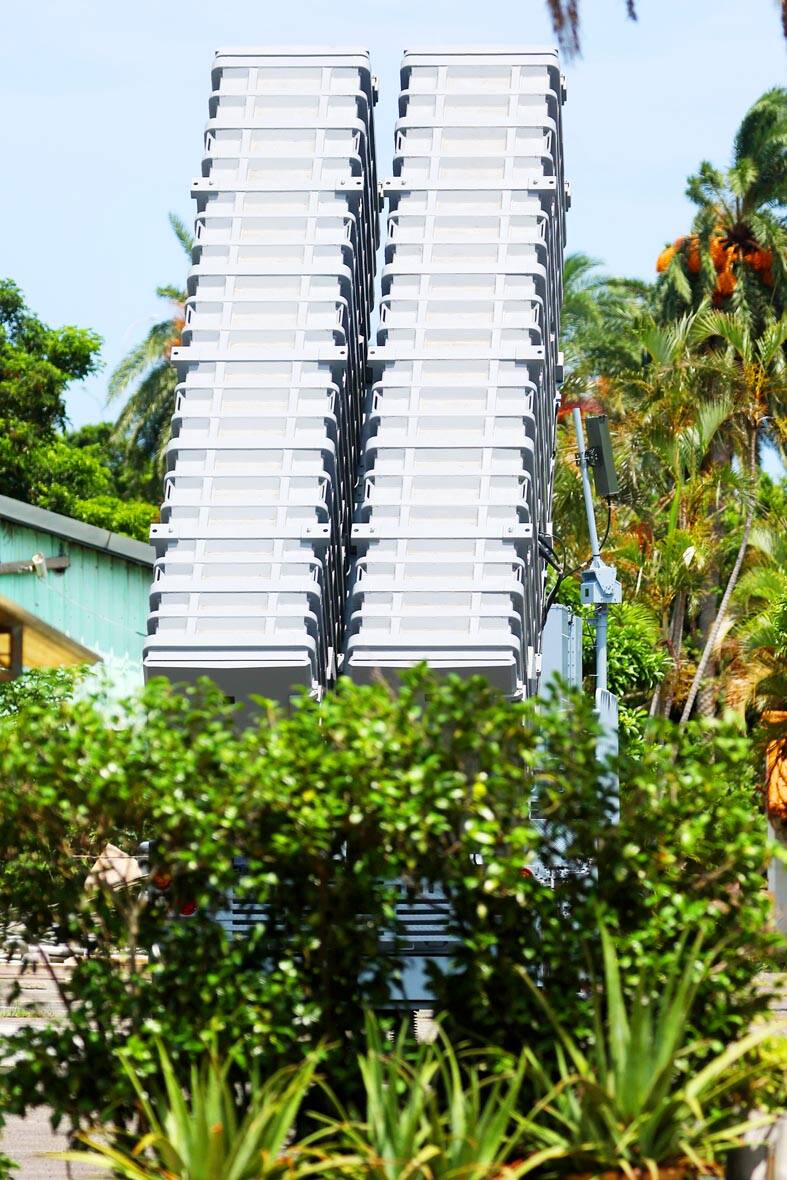
Photo: CNA
Also on the scene to provide security were armed vehicles from the army’s Guandu Area Command.
The armed forces are set to spend more than NT$44.1 billion (US$1.51 billion) to mass produce HF-3 missiles, both standard and extended-range variants, its plans showed.
As production is on schedule, the military has provided it to the missile group for operational use.
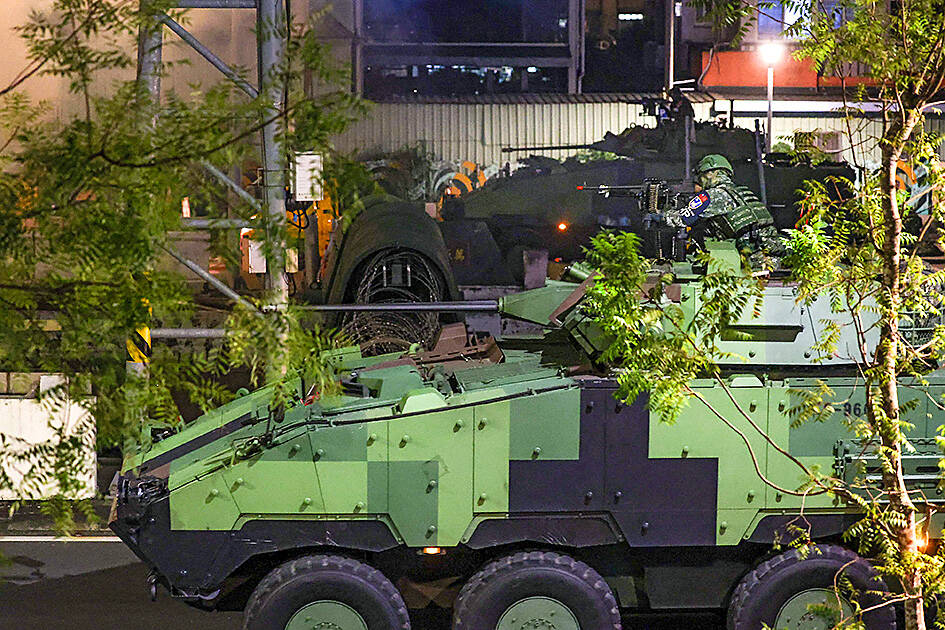
Photo: AFP
In the future, the missiles would also be deployed on navy frigates, as well as key bases in Taiwan’s north, south and east to make use of its long-term capabilities.
Meanwhile, a video released by the Presidential Office showed the president in front of a drone that had not been publicly revealed before. The drone has a fixed-wing configuration with horizontal main wings, an inverted V-shaped tailplane, four sets of rotors for vertical takeoff and landing and a pusher-type propeller mounted at the rear. Based on its configuration, it is believed to be the navy’s newly acquired land-based reconnaissance uncrewed aerial vehicle.
In Taipei, the 202nd Military Police Command practiced delaying a simulated PLA advance into the city by blocking and fortifying the Wanban Bridge (萬板大橋) that connects New Taipei City’s Banciao District (板橋) with Taipei’s Wanhua District (萬華), closing the bridge from 11pm on Monday to 6am yesterday.

Photo: AFP
The drill began with military police building a four-tier blockade on the bridge within two hours in anticipation of incoming PLA troops.
The temporary 690m-long blockade was made up of roadblocks, civilian buses and barbed wire barricades, as well as newly acquired Hesco bastions — modern, collapsible barriers made of wire mesh and fabric.
Used in Iraq and Afghanistan, the barriers were originally designed for flood control and military fortifications, and have the advantage of accelerating the construction of temporary defenses.
During the drill, military police first used drones to detect the PLA’s deployment remotely before simulating opening fire on Chinese troops.
The second part of the drill simulated PLA troops breaking through three of the four levels of the blockade set up by Taiwanese forces before being fired on by Taiwanese snipers from high points.
The exercise was a continuation of drills from yesterday, during which soldiers practiced using the Taipei MRT system to reinforce positions, reach a target area and engage the enemy.
In Lieyu (Little Kinmen, 烈嶼), which lies to the west of Kinmen County’s main island, a garrison was deployed to Kinmen Bridge (金門大橋) to guard critical infrastructure and counter an enemy invasion.
Reservists continued to participate in the military exercises and training in various locations across the nation.
In Miaoli County, reservists in the 302nd Infantry Brigade continued simulated combat drills and practiced battlefield medical evacuation operations.
Additionally, civilian urban resilience drills started yesterday in central Taiwan, including Taichung, and Miaoli, Nantou and Changhua counties.
They are to continue today in the south, tomorrow in northern Taiwan and in the east on Friday.
Additional reporting by Aaron Tu

MISINFORMATION: The generated content tends to adopt China’s official stance, such as ‘Taiwan is currently governed by the Chinese central government,’ the NSB said Five China-developed artificial intelligence (AI) language models exhibit cybersecurity risks and content biases, an inspection conducted by the National Security Bureau (NSB) showed. The five AI tools are: DeepSeek, Doubao (豆包), Yiyan (文心一言), Tongyi (通義千問) and Yuanbao (騰訊元寶), the bureau said, advising people to remain vigilant to protect personal data privacy and corporate business secrets. The NSB said it, in accordance with the National Intelligence Services Act (國家情報工作法), has reviewed international cybersecurity reports and intelligence, and coordinated with the Ministry of Justice Investigation Bureau and the National Police Agency’s Criminal Investigation Bureau to conduct an inspection of China-made AI language
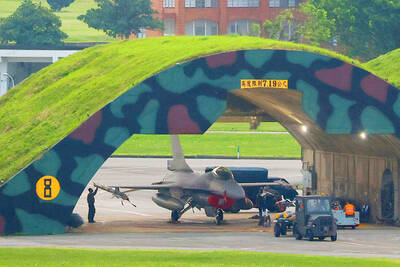
BOOST IN CONFIDENCE: The sale sends a clear message of support for Taiwan and dispels rumors that US President Donald Trump ‘sold out’ the nation, an expert said The US government on Thursday announced a possible sale to Taiwan of fighter jet parts, which was estimated to cost about US$330 million, in a move that an expert said “sends a clear message of support for Taiwan” amid fears that Washington might be wavering in its attitude toward Taipei. It was the first announcement of an arms sale to Taiwan since US President Donald Trump returned to the White House earlier this year. The proposed package includes non-standard components, spare and repair parts, consumables and accessories, as well repair and return support for the F-16, C-130 and Indigenous Defense Fighter aircraft,
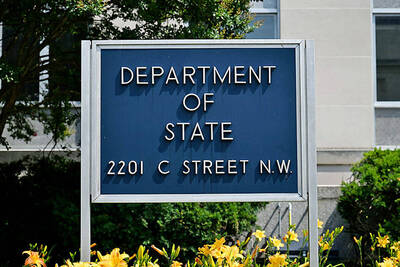
CHECKING BOUNDARIES: China wants to disrupt solidarity among democracies and test their red lines, but it is instead pushing nations to become more united, an expert said The US Department of State on Friday expressed deep concern over a Chinese public security agency’s investigation into Legislator Puma Shen (沈伯洋) for “secession.” “China’s actions threaten free speech and erode norms that have underpinned the cross-strait ‘status quo’ for decades,” a US Department of State spokesperson said. The Chongqing Municipal Public Security Bureau late last month listed Shen as “wanted” and launched an investigation into alleged “secession-related” criminal activities, including his founding of the Kuma Academy, a civil defense organization that prepares people for an invasion by China. The spokesperson said that the US was “deeply concerned” about the bureau investigating Shen

‘TROUBLEMAKER’: Most countries believe that it is China — rather than Taiwan — that is undermining regional peace and stability with its coercive tactics, the president said China should restrain itself and refrain from being a troublemaker that sabotages peace and stability in the Indo-Pacific region, President William Lai (賴清德) said yesterday. Lai made the remarks after China Coast Guard vessels sailed into disputed waters off the Senkaku Islands — known as the Diaoyutai Islands (釣魚台) in Taiwan — following a remark Japanese Prime Minister Sanae Takaichi made regarding Taiwan. Takaichi during a parliamentary session on Nov. 7 said that a “Taiwan contingency” involving a Chinese naval blockade could qualify as a “survival-threatening situation” for Japan, and trigger Tokyo’s deployment of its military for defense. Asked about the escalating tensions